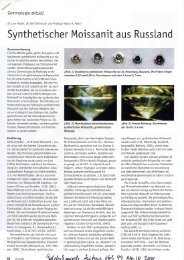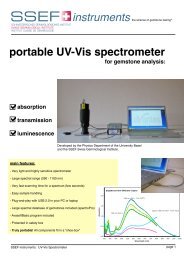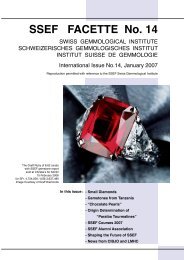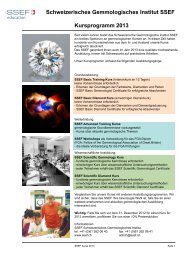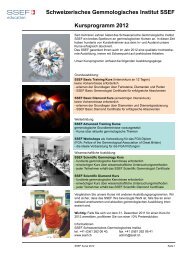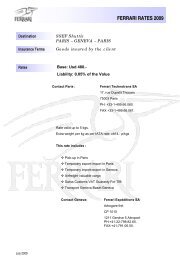SSEF FACETTE No. 17
SSEF FACETTE No. 17
SSEF FACETTE No. 17
You also want an ePaper? Increase the reach of your titles
YUMPU automatically turns print PDFs into web optimized ePapers that Google loves.
What does it take to issue a certificate at <strong>SSEF</strong><br />
First class service for your prestigious gemstones and jewellery<br />
Have you ever wondered why a first-class flight is<br />
more expensive than an economy class ticket?<br />
In the field of gemstone testing, the Swiss Gemmological<br />
Institute <strong>SSEF</strong> offers a first-class service,<br />
relying on three pillars, the excellence of our staff,<br />
an up-to-date scientific approach to analysis, and<br />
time, extended time for testing. All of which result<br />
in uncompromised quality. We have certified some<br />
of the finest coloured stones, diamonds and pearls<br />
available on the market in the last few years. Our<br />
clients assure us that our reports have become<br />
an important selling tool for them, because of our<br />
reputation for quality. Gemstone testing and certification<br />
is our daily business, and as such, we take<br />
care, that our service fulfils the high standards our<br />
customers expect from us.<br />
A service like this comes at a price. In times when<br />
the economic situation is tense everyone is trying to<br />
minimize his expenses. Therefore it is important that<br />
we can justify our tariff and to convince our clients<br />
of our scientifically sound and professional gemmological<br />
work.<br />
To illustrate our approach, we would like to present<br />
to you the steps taken to analyse a sapphire, revealing<br />
all the relevant information, before a <strong>SSEF</strong><br />
Gemstone Report is issued.<br />
The first steps:<br />
After arrival in the <strong>SSEF</strong> laboratory, the administration<br />
department gives the gemston a number, which<br />
can be seen as the <strong>SSEF</strong> report number on your<br />
certificate. The stone/jewellery is then immediately<br />
checked for any pre-existing damage.<br />
Two gemmologists check the sapphire quickly,<br />
using classic gemmological instruments, to see<br />
if the stone has been obviously treated or even if<br />
it is synthetic. A negative result like this would be<br />
communicated to our client immediately, thus avoiding<br />
time-consuming and costly analyses. It is the<br />
philosophy of the <strong>SSEF</strong> that every observation and<br />
conclusion, even for this first quick test, has to be<br />
confirmed by at least two gemmologists.<br />
If the stone has passed this first test a series of<br />
high-resolution photos are taken to illustrate the<br />
beauty of the stone on the certificate. The stone<br />
is then described in terms of shape, cutting style,<br />
proportions, measurements, weight, and colour<br />
saturation. Each of the observed/measured values<br />
is double checked by a second gemmologist.<br />
<strong>SSEF</strong> Facette <strong>No</strong>. <strong>17</strong>, © 2010<br />
Focus<br />
Kashmir sapphire of 42 ct of exceptional beauty, certified<br />
recently at <strong>SSEF</strong>. © <strong>SSEF</strong><br />
Sophisticated testing:<br />
The next steps include non-destructive testing with<br />
sophisticated instruments, such as ED-XRF for<br />
chemical analysis, UV-Vis spectrophotometer for<br />
absorption spectra, Raman analysis on inclusions<br />
and finally LIBS and FTIR analysis for treatment<br />
detection. The availability of these instruments is<br />
an advantage the <strong>SSEF</strong> has over many other labs.<br />
This technology goes had in hand with the experience<br />
of our technical and gemmological staff and<br />
their standardised analytical routines.<br />
The sapphire is first analysed by X-ray fluorescence<br />
(ED-XRF) to register its chemical composition,<br />
especially focussing on its trace elements, such as<br />
titanium, vanadium, chromium, iron, and gallium.<br />
To measure these elements in a sapphire requires<br />
a series of XRF analyses, using different excitation<br />
energies and prolonged accumulation times. By<br />
using the appropriate filters the signal can be optimized<br />
so that even concentrations as low as a few<br />
parts per million can be measured. For each gemstone<br />
variety, the <strong>SSEF</strong> has established a specific<br />
ED-XRF routine to optimize its chemical analysis.<br />
For our sapphire, the concentration of trace elements<br />
is one factor contributing to the determination<br />
of origin. It may also show evidence of treatment,<br />
such as surface diffusion with titanium, cobalt coating<br />
on the surface, and fissure filling with a highrefractive<br />
glass (e.g. lead glass), or even provide<br />
proof that it is a synthetic sapphire.<br />
page 3



